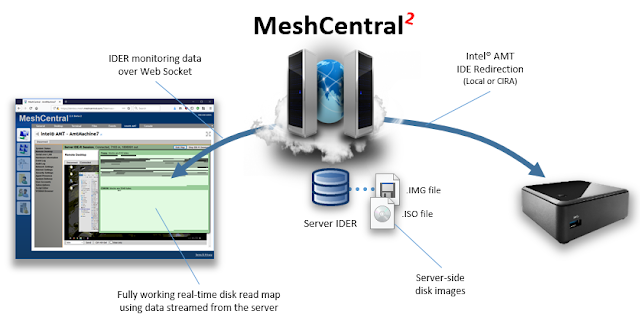MeshCentral2 - Server-side IDER & Real-time heat map
MeshCentral is an open source web based remote computer management web site. Last week, an all-new IDE redirect (IDER) library was unveiled completely built into JavaScript that allows MeshCommander to perform remote disk redirection to Intel® AMT. We also showed that we could use MeshCommander thru MeshCentral to perform IDER, using MeshCentral as a traffic relay. This week, we add upon what was announced last week with MeshCentral now gaining the ability to launch an IDER session from the server allowing faster, lower latency disk streaming over the Internet. On top of this, both MeshCommander and MeshCentral IDE redirection now feature a disk sector read “heat map” showing network sector reads in real time. In detail:
- MeshCentral IDER. With the latest MeshCentral server, users can now upload disk images (.img / .iso) into the server using the “My Files” tab. Then, they can signal the server to launch a disk redirection session to a target Intel AMT device. The server will do all the work of emulating the disk drives towards Intel AMT and send to the user real-time information about the disk redirection traffic. This works both with MeshCentral in LAN-mode (Local Intel AMT devices) and WAN-mode (Intel AMT using Client Initiated Remote Access (CIRA)). This way boosts performance compared to browser serves IDER since the disk image is served from the cloud server, cutting network traffic path by half.
- IDER Heat Map. Because I now use my own code to perform IDER, I get raw data of the disk usage pattern and so, can display this into a heat map of sector reads in real time. The new HTML canvas show a block for 1 or more disk sectors. This is automatically adjusted depending on the disk size. Each time a sector is read, the block is darken black using a 30% opaque brush, making the block darken more as the block is read multiple times. While it’s not directly useful, it shows clearly disk activity and makes for a more professional tool.
- IDER Read Queue. Along with many other improvements to IDER library, the new version is capable of batching read operations this is needed when on slow network links, especially when using CIRA. This makes for a more reliable IDER connection.
As usual, feedback is appreciated.
Enjoy,
Ylian
MeshCentral2: http://www.meshcommander.com/meshcentral2
Twitter: https://twitter.com/meshcentral
You can now see disk read operations in real time. The blocks
on the sector map get darker as the sector is read more than once.
Server-side IDER is performed by uploading disk images into the MeshCentral account.
Then selecting them when starting an IDER session.
Server-side IDER is faster due to lower latency and the user still gets a real-time
view of the IDER read operations using a data stream from the server.





